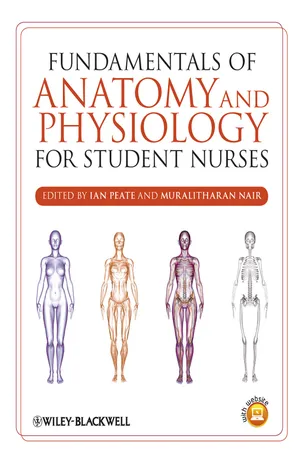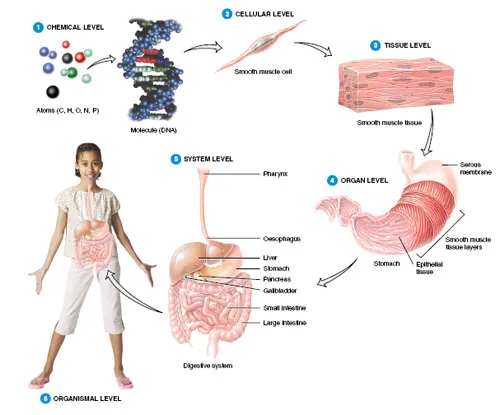
eBook - ePub
Fundamentals of Anatomy and Physiology for Student Nurses
This is a test
- English
- ePUB (mobile friendly)
- Available on iOS & Android
eBook - ePub
Fundamentals of Anatomy and Physiology for Student Nurses
Book details
Book preview
Table of contents
Citations
About This Book
The mind and the body, when working in harmony, is a fantastic system capable of extraordinary things.
With an applied, interactive, and highly visual approach, Fundamentals of Anatomy and Physiology for Student Nurses provides students with an exciting and straightforward understanding of anatomy and physiology, enabling them to deliver high quality care in any setting. This book covers the structure and functions of the human body, with clinical applications throughout.
Key features:
- A clear, straightforward book on anatomy and physiology for all students in nursing and allied health.
- Fully interactive, with an activity section at the end of each chapter, featuring multiple choice questions, diagram labelling, test your learning questions, crosswords, and 'find out more'.
- Generous, full colour illustrations throughout
- Clinical considerations and scenarios throughout showing how the material can be applied to daily practice
- A companion website where you'll find further exercises, illustrations, and interactive MCQs www.wiley.com/go/peate
Frequently asked questions
At the moment all of our mobile-responsive ePub books are available to download via the app. Most of our PDFs are also available to download and we're working on making the final remaining ones downloadable now. Learn more here.
Both plans give you full access to the library and all of Perlego’s features. The only differences are the price and subscription period: With the annual plan you’ll save around 30% compared to 12 months on the monthly plan.
We are an online textbook subscription service, where you can get access to an entire online library for less than the price of a single book per month. With over 1 million books across 1000+ topics, we’ve got you covered! Learn more here.
Look out for the read-aloud symbol on your next book to see if you can listen to it. The read-aloud tool reads text aloud for you, highlighting the text as it is being read. You can pause it, speed it up and slow it down. Learn more here.
Yes, you can access Fundamentals of Anatomy and Physiology for Student Nurses by Ian Peate, Muralitharan Nair, Ian Peate, Muralitharan Nair in PDF and/or ePUB format, as well as other popular books in Medicine & Nursing. We have over one million books available in our catalogue for you to explore.
Information
1
Basic scientific principles of physiology
Contents
Introduction
Levels of organisation
Characteristics of life
Bodily requirements
Atoms
Atomic number
Carbon atom
Molecules
Chemical bonds
Ionic bonding of atoms
Ions
Covalent bonds
Polar bonds
Electrolytes
Elements
Properties of elements
Compounds
Chemical equations/chemical reactions
Acids and bases (pH)
Blood and pH values
Homeostasis
Organic and inorganic substances
Examples of organic substances
Examples of inorganic substances
Units of measurement
Conclusion
Glossary
References
Activities
Test your knowledge
- What are the three basic components of an atom?
- What are the essential requirements of all organisms (including humans)?
- Why is it important for atoms to be able to bind together?
- What is a pH scale?
Learning outcomes
On completion of this chapter, the reader will be able to:
- Describe the levels of organisation of a body
- Describe the characteristics of life
- Understand and explain an atom and how it relates to molecules
- Describe and understand the ways in which atoms can bind together
- Describe elements and their characteristics
- Understand how to read chemical equations
- Describe the pH scale and its importance to life
- List the differences between organic and inorganic substances
- List the various ways in which we measure things.
Introduction
Learning about the physiology of the body is very much like learning a foreign language – there is new vocabulary, new grammar and new concepts to learn and understand. This first chapter introduces you to this new language so that you can then use your knowledge to understand the physiology of the different parts of the body that are discussed in all the other chapters of this book.
First of all there are two terms to learn and understand – namely, anatomy and physiology:
- Anatomy is the study of structure
- Physiology is the study of function.
However, structure is always related to function because the structure determines the function, which in turn determines how the body/organ, etc. is structured – the two are interdependent.
Levels of organisation
The body is a very complex organism which consists of many components, starting with the smallest of them – the atom – and concluding with the many organs that are found within the body (Figure 1.1). Starting from the smallest component and working towards the largest, the body is organised in this way:
- The atom – e.g. hydrogen, carbon
- The molecule – e.g. water, glucose
- The macromolecule (large molecule) – e.g. protein, DNA
- The organelle (found in the cell) – e.g. nucleus, mitochondrion
- The tissues – bone, muscle
- The organs – e.g. heart, kidney
- The organ system – e.g. skeletal, cardiovascular
- The organism – e.g. human, cat.
Characteristics of life
All living organisms have certain characteristics in common. Although these characteristics may differ from organism to organism, they are important for the maintenance of life. These characteristics are:
- Reproduction – both at the micro- and the macro-level, reproduction is essential. At the macro-level it is the reproduction of the organism and at the micro-level it is the reproduction of new cells to maintain the efficiency and growth of the organism
- Growth – essential for the growth and development of an organism
- Movement – both change in position and motion are parts of movement. This characteristic is essential to allow the organism to seek out nutrition and partners for reproduction, as well as to escape predators
Figure 1.1 Levels of organisation of the body (Tortora and Derrickson 2009)

- Respiration – respiration is important for obtaining oxygen and releasing carbon dioxide (or obtaining carbon dioxide and releasing oxygen if a green plant), known as external respiration, as well as releasing energy from foods (internal respiration)
- Responsiveness – this allows the organism to respond to changes, for example in the environment or to other stimuli
- Digestion – this is the breakdown of food substances, so that the organism can produce the energy necessary for life
- Absorption – the movement of substances (including digested food) through membranes and into body fluids, including blood and lymph, which then carry the substances to the parts of the organism requiring them
- Circulation – the movement of substances through the body in the body fluids
- Assimilation – the chan...
Table of contents
- Cover
- Title Page
- Copyright
- Contributors
- Acknowledgements
- Copyright acknowledgements
- Introduction
- 1: Basic scientific principles of physiology
- 2: Cells: cellular compartment, transport system, fluid movements
- 3: The immune system
- 4: Tissue
- 5: The skin
- 6: The nervous system
- 7: The endocrine system
- 8: The skeletal system
- 9: The muscular system
- 10: The cardiac system
- 11: The respiratory system
- 12: The circulatory system
- 13: The digestive system and nutrition
- 14: The renal system
- 15: The reproductive systems
- 16: The special senses
- 17: Genetics
- Index